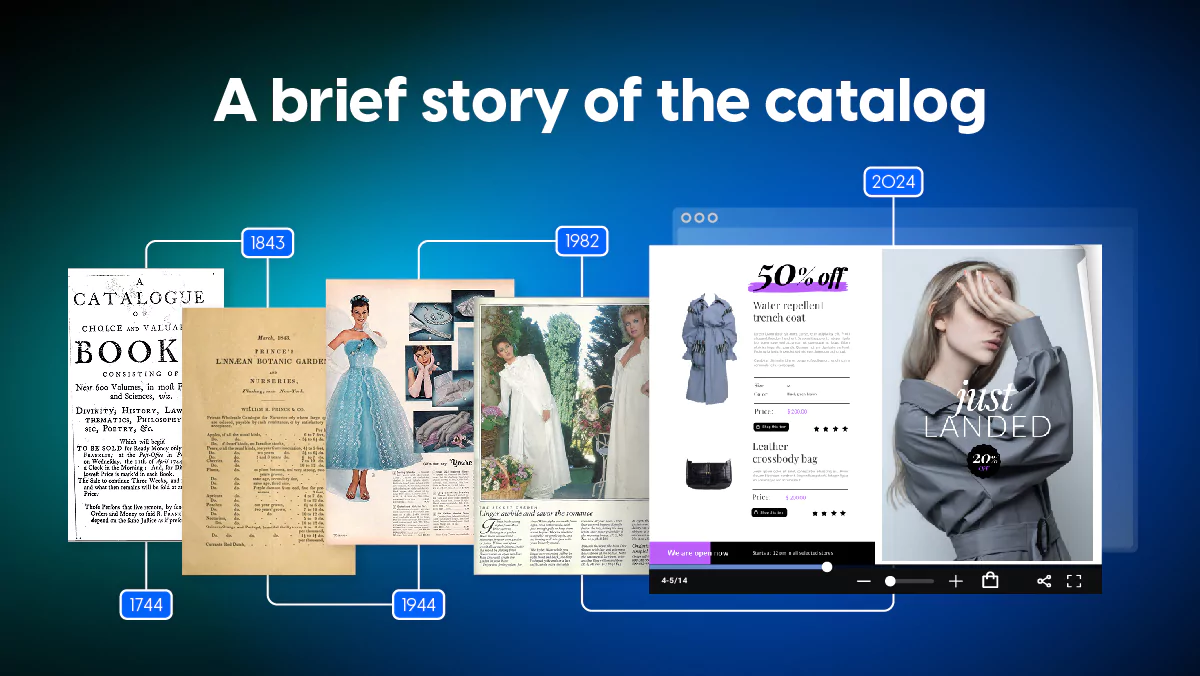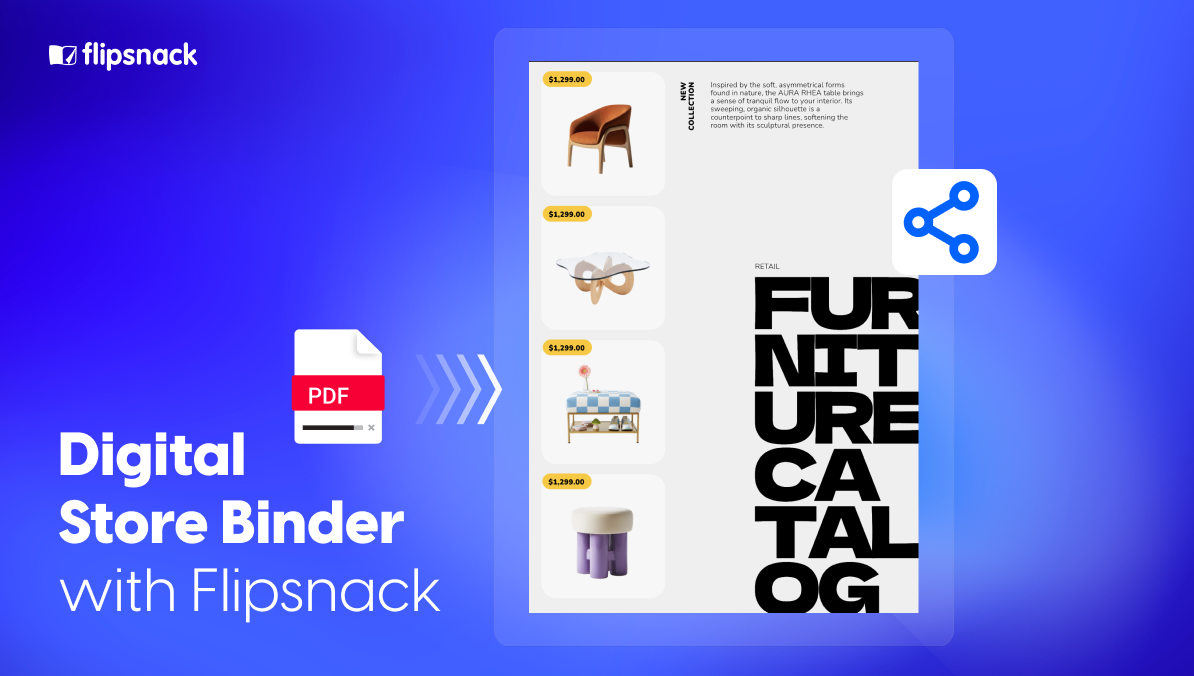Flipping through history. A brief story of the catalog
Ever since we can remember, catalogs have been an essential part of the shopping experience. They are so deep-rooted in our daily lives that people easily forget that there was a time when the catalogs were black and white and looked like old-fashioned and cheap newspapers. It’s really hard to recall that, right? Especially nowadays, when all the catalogs we’re flipping through are multicolored and very well organized.
But trust me, there’s a lot of history when talking about the first-ever published catalog. Wondering why? Well, the story of the catalog began long,
Keep on reading to find out when and why the first catalog was created, which ones are the longest-lasting or most popular catalogs; and also to see how they developed from the past till present.
Once upon a time…there was the first catalog ever published (1498)
Believe it or not, the story of the catalog began in Venice, in 1498! Aldus Pius Manutius – an Italian humanist, scholar, and educator – published the first catalog ever. He founded his company “The Aldine Press” at Venice in 1495 and wanted to accurately print the first editions of many Greek and Latin classics.
But his biggest desire was to present and sell these books to the Venetians; that’s why he chose to publish a catalog of all the books he was printing. And this, ladies and gentlemen, this is why and when the first ever catalog appeared. Interesting, right?

The story of the catalog started with the seed companies (1771)
I know it might seem strange and unbelievable, but the seed companies had a great impact upon the story of the catalog. Thanks to them, the catalogs started to develop progressively.
Everything began in 1667, when a simple English gardener, William Lucas, decided to publish a catalog with seed prices for his clients. He created a real trend that became popular even in the colonial America, where William Prince of the Prince Nurseries (in this context, a nursery represents young plants) published a catalog of fruit trees in 1771.
Here we have an extract from a Prince Nursery catalog from 1843. It looks like an ancient piece of paper, right? You wouldn’t think that it’s actually a page from a catalog.
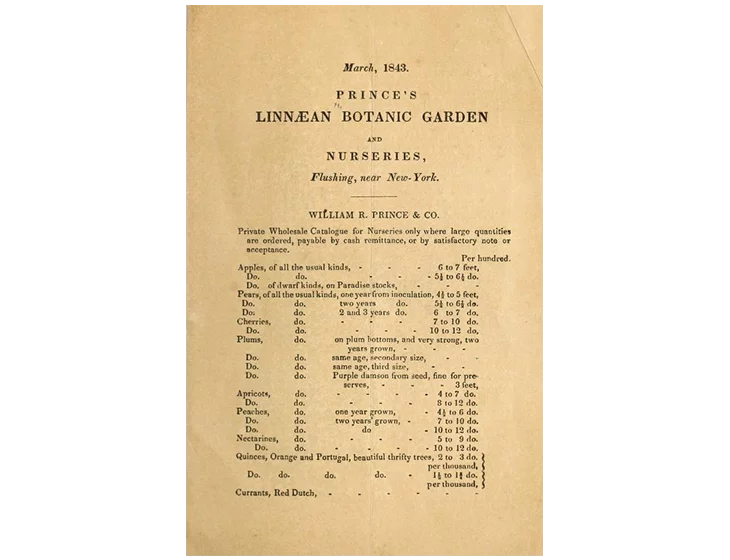
The mail order concept invented by Benjamin Franklin (1744)
Yep, you read it correctly the first time. Benjamin Franklin is usually known for his politician and scientist skills, and only a few people know that he also invented the mail order business. Let me briefly explain to you what this concept is all about and why is it so important for the story of the catalog.
The mail order concept represents the process of selecting an item through a catalog, and also of sending the company the client’s order together with money for the product plus shipping through post. The customer would receive his order by post in the next weeks. It does sound familiar, right? We still use this mail order process nowadays.
In 1744, Benjamin Franklin published a catalog of science books. Its name was “A Catalogue of Choice and Valuable Books, Consisting of Near 600 Volumes, in most Faculties and Sciences”, and the first page presented the terms of sale for the books he wanted to sell:
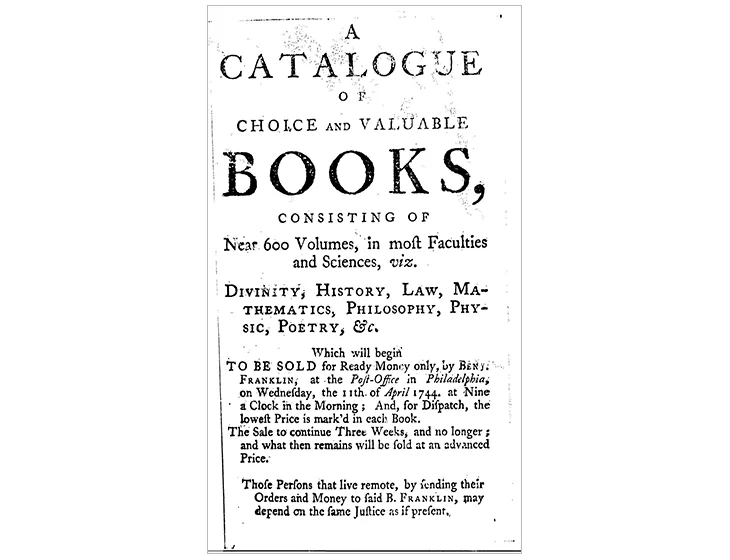
What’s really important on this opening page is the fact that Benjamin Franklin made it possible for people to acquire his books without visiting the stores: “Those Persons that live remote, by sending their Orders and Money to said B. Franklin, may depend on the same Justice as if present.” This is what mail order catalogs do.
The mail order catalogs industry increases more and more (1845)
The story of the catalog becomes more and more fascinating, especially around the 1830s when mail order catalogs increased significantly in popularity. Both in North America and Canada. The very first
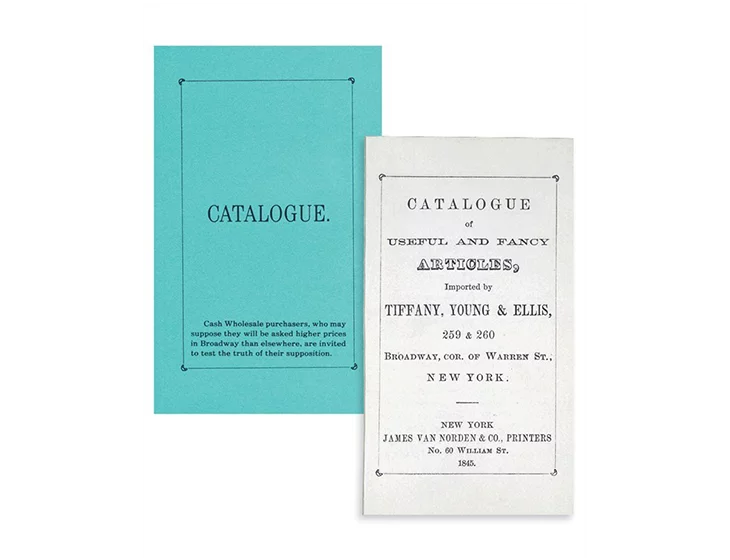
Fast forwarding a couple of years, we reach 1861 when Pryce Pryce-Jones created the first contemporary mail-order catalog business. This marked the beginning of the wholesale concept (selling products at a larger scale). It marked a drastic evolution from earlier catalogs, which were often limited in scope. Pryce-Jones’s innovation expanded the range of products available through mail order, making everyday items accessible to a broader audience.
Does 18th of August say something to you? Well, if you’re passionate about catalogs, you should celebrate this day from now on. It’s the National Mail Order Catalog Day. Wondering why? Because the first mail order catalog meant for the general public was produced on August 18, 1872 by the Montgomery Ward, a distinct American retail enterprise popular in that period.
The golden-era of mail order catalogs
Normally, the wars tend to worsen the political, financial and economic conditions; but surprisingly, both World Wars had a positive impact on the use and distribution of catalogs. It even marked a rise in consumerism. And also a rise in the way the story of the catalog has developed.
The
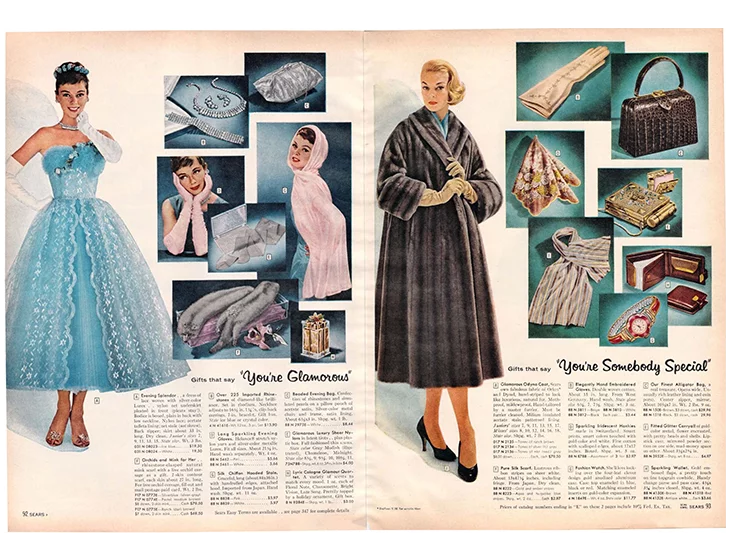
Not long after, J.C. Penney’s 1963 catalog represented a strategic shift in retail. We were introduced to catalogs as a supplementary channel to enhance the in-store shopping experience. By allowing customers to place orders from the catalog while physically present in the store, J.C. Penney pioneered an integrated approach to retail. This innovation set the stage for the coexistence of physical and catalog-based shopping. They offered consumers greater convenience and flexibility in how they engaged with the brand.
Fast forward to the 1980s, the catalog evolved into a crucial main tool of direct advertising. There were many companies that increased their business with the help of catalogs. In 1982, the spring/summer Victoria’s Secret catalog was a huge success. Apparently, 55% of their $7 million annual sales came from this catalog sales. Nicely done, right?
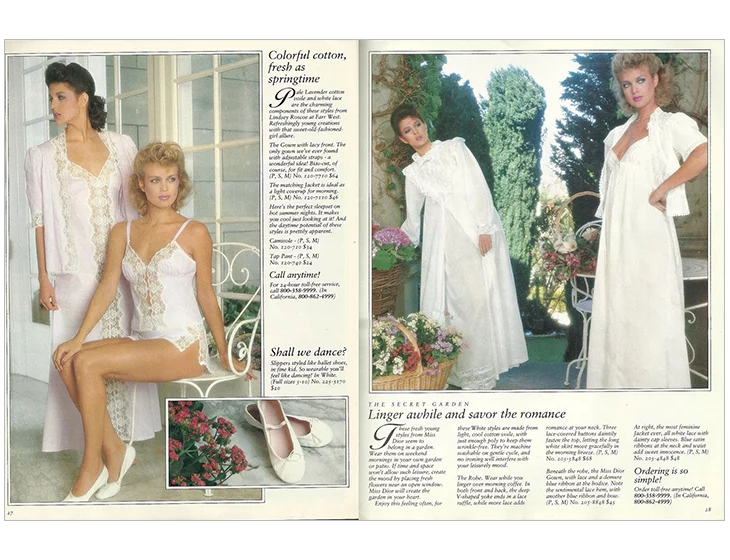
The 1990s onwards – the first digital book is published
The 1990s witnessed a paradigm shift as catalogs transitioned into the digital realm. Amazon.com, initially an online bookstore, published the first digital book in 1995, fundamentally altering how catalogs were distributed and accessed. The digital format allowed for easier navigation, searchability, and real-time updates. It revolutionized the way consumers interacted with product listings. This transformation set the stage for the widespread adoption of e-commerce and paved the way for the digitization of catalogs across various industries.
Apple’s introduction of the iPhone in 2007 marked a moment for catalog browsing and shopping. The availability of apps and mobile-friendly catalogs on smartphones accelerated the digital shift, providing consumers with a more convenient and accessible way to browse and purchase products. The iPhone became a catalyst for a new era in catalog shopping, emphasizing the importance of mobile devices in shaping the future of retail.
The rise of digital catalogs on social media platforms
In 2014, the rise of digital catalogs on social media platforms, specifically Instagram and Pinterest, transformed the way products were showcased and marketed. Brands started using visually appealing content, influencers, and user-generated imagery to create immersive and shareable catalogs. This shift emphasized the importance of engaging storytelling and visual aesthetics to captivate a global audience.
The COVID-19 impact on digital catalogs
The COVID-19 pandemic in 2020 fostered the adoption of online catalogs and e-commerce. As lockdowns and social distancing measures restricted traditional in-person shopping, consumers turned to digital catalogs for their convenience and safety. Retailers, recognizing this shift in buyers’ behavior, invested in enhancing online catalog experiences. They optimized websites for seamless navigation, and implemented features such as virtual try-ons.
The future of catalogs – virtual and augmented reality
We could say that the story of the catalog is still being written these days. Especially the story of the digital catalog that becomes more popular and requested by people. Nowadays, customers all over the world have this great opportunity to flip through an online catalog. With the high rise of technology at this time, it’s no wonder that the digital catalogs have this great success.
But print is not dead and will never be, and some people still prefer the printed catalogs. There’s no need to expand on this fight between printed and digital catalogs now, ‘cause it’s a battle that will never end. Regardless of someone’s choice, the main point is that catalogs developed increasingly well since the 1800s till present days and are still doing a great job in the sales field.
In 2024, virtual and augmented reality technologies offer immersive and interactive shopping experiences. Consumers can engage with products in virtual spaces, try them before purchasing, and receive personalized recommendations. These advancements enhance the online shopping experience and bridge the gap between digital and physical retail. As technology continues to evolve, virtual and augmented reality are predicted to play a central role in the ongoing evolution of catalog shopping.
There’s a lot of historical information above, so we’ve decided to summarize everything with the help of an infographic. Hope you like it and consider it useful, too!

Frequently asked questions
Catalogs have significantly shaped consumer culture by making a wide range of products accessible to a broad audience, fostering a culture of convenience and choice. This accessibility has changed shopping habits, encouraging the browsing and comparison of goods from the comfort of one’s home, leading to the rise of consumerism and the modern shopping experience.
Catalogs have played a crucial role in global trade by introducing consumers to products from around the world, thus breaking down geographical barriers to commerce. They have facilitated the expansion of markets for manufacturers and retailers, making it easier to reach a global audience and contributing to the globalization of trade.
Environmental concerns are driving the shift from print to digital catalogs, reducing the need for paper and the carbon footprint associated with physical distribution. This transition supports sustainability initiatives by minimizing waste and promoting more eco-friendly marketing practices, aligning with growing consumer preference for businesses that prioritize environmental responsibility.
Conclusion
Today’s article has been quite a ride, but it was an enjoyable and informational one. It really helped us all to gain a better understanding of the story of the catalog and the history behind it. Because we are so fascinated by this subject, we’ve decided to go the extra mile and created a specific video in this regard.
Hopefully, you’ll enjoy both the video and the information we’ve put to create this article about the history of catalogs. Let us know what you think in the comments section below!
